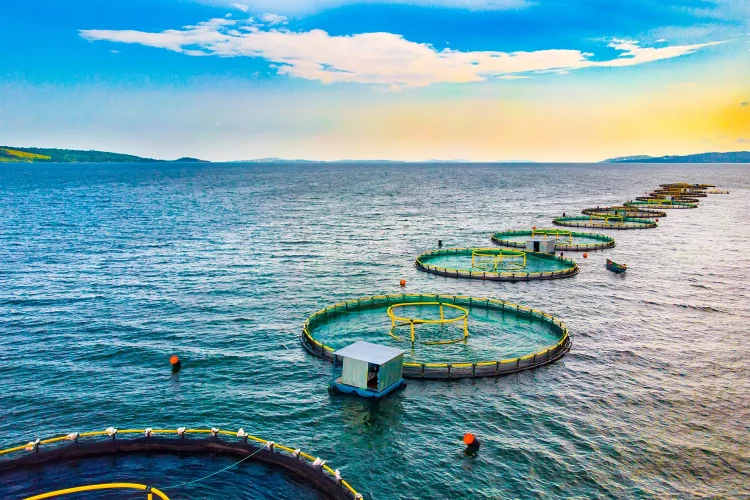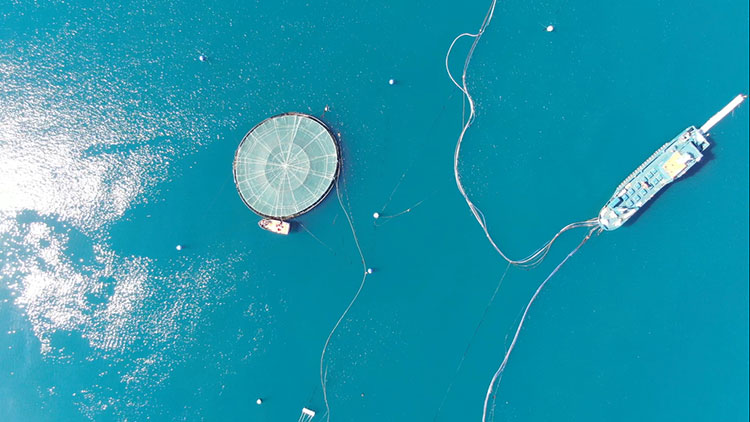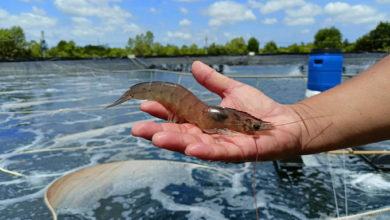Developments in offshore aquaculture and renewable energy production
Despite promising synergies, several questions and considerations must be addressed to realize the potential

The authors discuss the promising synergies between offshore aquaculture and renewable energy production, highlighting several challenges that must be addressed to realize their full potential. Photo by Mohsen Taha (CC BY-SA 4.0, https://creativecommons.org/licenses/by-sa/4.0, via Wikimedia Commons).
Offshore aquaculture involves the cultivation of various marine organisms like fish, crustaceans, mollusks and aquatic plants in the open ocean, away from traditional coastal aquafarming regions. This new farming approach offers many opportunities and ample farming space with less competition from other coastal, competing human activities like shipping, tourism, recreation, conservation, urban development and others.
Additionally, these locations away from the coast typically have better water quality and more stable water temperatures. And waves and currents facilitate the dispersing and diluting of waste, reduce biofouling, and prevent degradation of the marine ecosystem often associated with nearshore, intensive aquaculture farms.
Alongside offshore aquaculture, there has been significant interest, research and development in harnessing offshore renewable energy sources, such as wind, solar, wave, and tidal currents. Currently, offshore wind energy is the primary contributor to offshore renewable energy production, with a global cumulative installed capacity of 64.3 GW as of 2022.
Globally, there is a strong commitment to further expand offshore energy production. For instance, the European Union has set a target for 2050, aiming for 350 GW from offshore wind and 188 GW from wave and tidal energies. However, offshore renewables face challenges due to the relatively new nature of the technologies involved and the harsh offshore environments in which they operate. The levelized cost of electricity (LCOE) generated from offshore renewable sources remains relatively high. Significant investment, research, and development efforts are underway to further reduce LCOEs.
This article – summarized from the original publication (Nguyen, H.P. and C.M. Wang. 2024. Advances in Offshore Aquaculture and Renewable Energy Production. J. Mar. Sci. Eng. 2024, 12(9), 1679) – discusses promising synergies between offshore aquaculture and renewable energy production.
Improved cage/net systems
Traditional nearshore fish farming depends significantly on floating open net systems, with floating structures constructed from HDPE (high-density polyethylene) pipes or galvanized steel frames supported by plastic buoyant boxes. Such infrastructure systems have been used in areas with wave heights of up to 3 meters. However, modifications and innovations in infrastructure are needed for offshore fish farming in higher-energy sea conditions, and significant efforts are being invested in three approaches for offshore fish farming infrastructure.
The first approach is to modify nearshore fish pens to increase their strength, stiffness and stability to survive offshore sea conditions, although the floating HDPE collars and nets tend to deform significantly. The second approach is to submerge fish pens below the water surface to avoid strong surface waves, especially during storms. Studies and trials are examining structural performance, submergence techniques, and fish health in submerged states.
The third approach for farming fish offshore is to employ large, stiff-frame structures constructed from steel pipes or bundles of HDPE pipes. This approach appears to be the most adopted method in offshore areas because of the robustness of these structures in severe offshore environments, although high infrastructure costs remain an issue for adoption on a large scale.
Seaweed culture
Farming of seaweeds is receiving more attention due to the wide applications of many macroalgae species, such as in Asian cuisines, animal feed, cosmetics, pharmaceutical products, and fertilizers. Seaweed farming infrastructure in nearshore sites is commonly seen as low-tech, consisting of nets, ropes, wooden piles, bamboo frames, buoys, and seabed anchors. Ongoing efforts are examining more robust seaweed farming infrastructures constructed from HDPE or even steel for offshore deployment.
Optimizing seaweed farming infrastructure and co-locating with offshore fish farms are receiving attention as cost-reduction approaches. Furthermore, co-locating with fish farms may improve the sustainability of these aquaculture farms, as seaweeds can help remove phosphorus and nitrogen from the waste from the fish cages.
Offshore wind energy
Offshore wind energy has experienced rapid growth in recent decades, with a remarkable increase in cumulative installed capacity of over 700 times from 2006 to 2022. The technologies associated with offshore wind are relatively mature and have been commercialized on a large scale, especially for bottom-founded wind turbines that are supported by monopile, tripod, or jacket structures. These technologies can be economically viable for waters up to 60 meters deep.
For greater water depths, floating wind turbines are being developed for deployment; they are in the early phases of development, with minimal deployments and operations. Floating wind turbines consist of a floater structure and upper turbines. Since the turbine design is rather standard, the focus is on the floater. As water depth increases, floaters can take the form of a barge, semi-submersible, spar, or tension leg platform. Efforts are being made to conduct more refined analyses and structural optimizations of floaters and their mooring systems to enhance safety and reduce costs.
Solar energy
Floating solar installations are used in calm waters such as lakes and reservoirs, but there is also interest in harnessing solar energy from the ocean, where solar infrastructure must withstand strong waves and water currents. Two approaches have been proposed: one uses a robust semi-submersible frame to support photovoltaic (PV) panels, while the other uses a large membrane held by HDPE structures, allowing the structure to flexibly deform with waves. Offshore solar research has been limited, and further research is needed to examine the safety of the infrastructure under storm conditions.
Wave energy
Harnessing wave motions to generate electricity has been of interest since the 1970s, but technologies for wave energy conversion have yet to come together at scale. While some systems have shown the ability to deliver electricity in trial deployments, issues such as safety, durability of structures, and the cost of generated electricity remain challenging. Designs of wave energy converters vary; common types include oscillating water columns, attenuators, point absorbers, and oscillating wave surge converters. Recent research has focused on integrating wave energy converters with other marine structures and developing new generations of power take-off systems to reduce the cost of electricity generated from waves.
Tidal energy
Tidal currents offer another form of offshore renewable energy, which can be converted into electricity using horizontal axis turbines or kite devices. The horizontal axis turbines, similar to but smaller than wind turbines, are the most common design. Current research and development in this common design concept show promise for further cost reductions and improved safety, indicating the potential for the widespread expansion of tidal current energy.
Co-locating aquaculture and energy harnessing
Another advancement in offshore aquaculture farms and renewable energy production farms is to integrate or co-locate these two kinds of farms, which offer compelling synergies and opportunities for sustainable ocean development.
By co-locating aquaculture facilities within offshore wind farms, stakeholders can capitalize on shared infrastructure, mooring systems and resources, optimizing spatial utilization and reducing environmental footprints. Offshore wind farms provide stable platforms for anchoring aquaculture infrastructure while utilizing excess space between wind turbines for aquaculture activities. Moreover, the presence of wind or marine energy infrastructure can mitigate energy costs for aquaculture operations, fostering economic viability and long-term sustainability by eliminating the use of fossil fuels in marine aquaculture.
Perspectives
Despite the promising synergies between offshore aquaculture and renewable energy production, several challenges and considerations must be addressed to realize their full potential. These include regulatory frameworks, environmental impact assessments, technological compatibility and stakeholder engagement. Regulatory frameworks governing offshore activities must be adapted to accommodate integrated aquaculture-energy projects, ensuring compliance with environmental standards and permitting requirements.
Environmental impact assessments are essential to evaluate the ecological implications of co-located operations and the effects on marine ecosystems. Moreover, technological compatibility between aquaculture and renewable energy infrastructure is crucial to optimize resource utilization and mitigate operational risks. Innovative solutions, such as multi-use platforms and modular systems, can facilitate synergistic deployment while addressing technical constraints and operational challenges.
Significant stakeholder engagement is vital to advance collaboration and address concerns among diverse stakeholders, including government agencies, industry partners, local communities, and environmental organizations. Transparent communication, stakeholder consultation, and participatory decision-making processes are essential to build trust and consensus around integrated aquaculture-energy projects.
Source: Globalseafood






